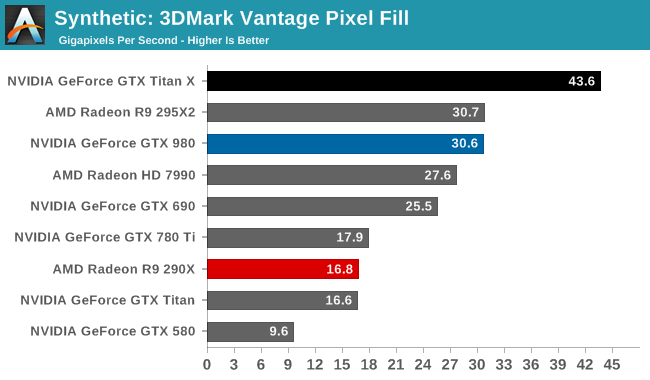The NVIDIA GeForce GTX Titan X Review
by Ryan Smith on March 17, 2015 3:00 PM ESTSynthetics
As always we’ll also take a quick look at synthetic performance. In the case of GTX Titan X and its GM200 GPU, what we should see here is a pretty straightforward 30-40% increase in performance, owing to GM200’s evenly scaled out Maxwell 2 design.

At over 300fps even with TessMark’s most strenuous test case, the GTX Titan X is unsurprisingly the top card at tessellation performance. Designed to deliver up 24 triangles/clock, theoretical geometry throughput stands at a staggering 24B triangles/second.


Meanwhile 3DMark’s fillrate tests reiterate Maxwell’s biggest and smallest improvements over Kepler. With a decrease in ALU:TEX ratios, overall texture throughput on the GTX Titan X is very similar to the GTX 780 Ti. On the other hand thanks to improved memory compression GTX Titan X has a pixel fillrate unlike anything else. This in turn is a big part of the reason NVIDIA is pushing that GTX Titan X be paired up with 4K monitors, as it offers the kind of fillrate necessary to drive such a high resolution.










276 Comments
View All Comments
dragonsqrrl - Tuesday, March 17, 2015 - link
Had no idea that non reference Hawaii cards were generally undervolted resulting in lower power consumption. Source?chizow - Tuesday, March 17, 2015 - link
There is some science behind it, heat results in higher leakage resulting in higher power consumption. But yes I agree, the reviews show otherwise, in fact, they show the cards that dont' throttle and boost unabated draw even more power, closer to 300W. So yes, that increased perf comes at the expense of higher power consumption, not sure why the AMD faithful believe otherwise.FlushedBubblyJock - Saturday, March 21, 2015 - link
Duh. It's because they hate Physx.Kutark - Tuesday, March 17, 2015 - link
Yes, some of the new designs from aftermarket are cooler and quiter, but they dont use less power, the GPU is generating the power, the aftermarket companies can't alter that. They can only tame the beast, so to speak.Yojimbo - Tuesday, March 17, 2015 - link
Would be a good point if the performance were the same. But the Titan X is 50% faster. The scores are also total system power usage under gaming load, not card usage. Running at 50% faster frame rates is going to tax other parts of the system more, as well.Kutark - Tuesday, March 17, 2015 - link
You're kidding right. Your framerate in no way affects your power usage.nevcairiel - Tuesday, March 17, 2015 - link
Actually, it might. If the GPU is faster, it might need more CPU power, which in turn can increase power draw from the CPU.DarkXale - Tuesday, March 17, 2015 - link
Of course. Its the entire point of DX12/Mantle/Vulcan/Metal to reduce per-frame CPU work, and as a consequence per-frame CPU power consumption.Yojimbo - Tuesday, March 17, 2015 - link
The main point of my post is that Titan X gets 50% more performance/system watt. But yes, your frame rate should affect your power usage if you are GPU-bound. The CPU, for instance, will be working harder maintaining the higher frame rates. How much harder, I have no idea, but it's a variable that needs to be considered before testbug00's antecedent can be considered true.dragonsqrrl - Wednesday, March 18, 2015 - link
Actually frame rates have a lot to do with power usage.I don't think that needs any further explanation, anyone who's even moderately informed knows this, and even if they didn't could probably figure out why this might be the case in about 10 seconds.